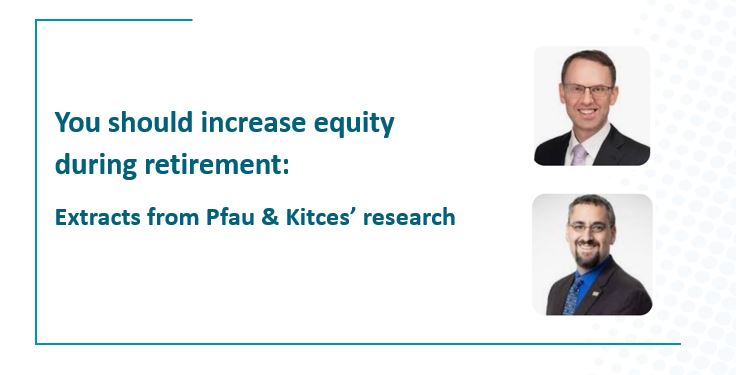Key takeaways
- Conventional wisdom states that one should decrease equity exposure as one nears and gets into retirement
- Bill Bengen’s research on the 4% rule suggested it was better to hold one’s equity allocation steady at the level at which one started retirement
- Pfau & Kitces’ research suggests that increasing equity allocation steadily through retirement is the best approach
- Their research shows that an increasing equity glidepath that goes from 30% to 70% equity allocation during retirement has the max probability for success
- Further, their research shows that even in cases where the portfolio did not make it through all of retirement, (bottom 5th percentile) the portfolio with a rising equity allocation lasted longer
- Kitces research shows strong correlation between returns during the first 15 years of retirement and safe withdrawal rates
- This means that retirees have to focus on implementing strategies to minimize risk / maximize returns during the first 15 years even if / when returns are poor during that time
- One sure fire way to ride out a poor equity market over the first 15 years then would be to keep buying into it. This is exactly what Pfau & Kitces’ research validates.
Conventional wisdom on equity allocation during retirement
Most conventional wisdom on personal finance & investing suggests that one should reduce equity allocation (a descending equity glidepath) as one ages and in particular during retirement. This sounds like common sense because as one ages one has less years left to be able to recover from long downturns of the stock market. In addition, one’s earning potential reduces during retirement and consequently there’s more need for stability, surety & regularity of investment income.
Bengen’s research: Suggests holding initial equity allocation
In Bill Bengen’s research on the 4% rule, he found that it was counterproductive to reduce equity allocation during retirement & he suggested holding it steady at whatever allocation you started retirement at. In addition, his research suggested that holding an initial equity allocation between 50% & 75% and if held closer to 75% it was more beneficial.
Results of Pfau & Kitces’ research on equity glidepaths
Wade Pfau (one of the most respected names in finance research in the world today) & Kitces’ research has shown that a rising equity glidepath i.e. a constantly INCREASING allocation to equity actually results in better outcomes through retirement
Retirement success rate data
Their research in the chart below shows that the probability of success is higher for a constantly increasing equity allocation compared to a static allocation through retirement. This goes against most of the conventional wisdom that states that one should rather reduce equity allocation during retirement.
In the chart below, the starting equity exposure is on the vertical axis, and the ending allocation is on the horizontal axis. Thus, for instance, a portfolio that starts at 60% in equities and ends at 60% in equities (the intersection of the 60% row and column) has a 93.2% probability of success. However, a portfolio that starts at 30% in equities and finishes at 70% in equities actually has a higher (95.1%) probability of success.

Note: The chart above shows probability of success (i.e. portfolio lasting 30 years or more) using historical returns with various asset allocations based on a 4% withdrawal rate approach.
Increased portfolio longevity even in failure scenarios
Pfau & Kitces research further indicated that even in the lowest 5% of cases where the portfolio failed to last a full 30 years, a rising equity allocation through retirement lasts longer than a static allocation.
As you can see from the chart below, the 30% to 70% glidepath portfolio lasts for 30 years, while the constant 60% equity exposure portfolio is depleted in 27.7 years

Correlation between safe withdrawal rates & returns of first 15 years of retirement
As per Kitces’ research, returns over the first 15 years of the retirement time horizon have a strong relationship & correlation to safe withdrawal rates. In fact, the 15-year real (inflation-adjusted) return of the portfolio actually has a whopping 0.91 correlation to the safe withdrawal rate, as shown in the graph below.

Summary
In summary, given that the returns you earn on your portfolio during the first 15 years of retirement affect retirement outcomes greatly, it would be prudent to adopt a strategy that minimizes your risk during the first 15 years of retirement.
Now if we go with what Dr. Bernstein often recommends & follow “Pascal’s wager”, we have to plan for the worst case i.e. stock returns are poor during the first 15 years of your retirement.
One sure fire way to ride out a poor equity market over the first 15 years then would be to keep buying into it.
The above intuitive approach ties in neatly with the data from Pfau & Kitces’ research indicating that a rising equity glidepath enhances retirement outcomes.
Disclaimer: I am not a financial advisor. My articles are meant for people who are not savvy or well versed with personal finance and investing and find it difficult to grasp all the jargon typically used when discussing such topics. I hope to be able to demystify investing and make it as simple as possible for everyone. I’ve invested in Mutual funds for approx. 24 years. I’ve also been a diligent student of the subject of investing over the past 24 years learning & applying the writings of luminaries in the field. In these articles I’m merely sharing my experience & learning from that investing journey and the books of luminaries in the field in the hope that it might help others in some way. I am in no way directly or indirectly claiming to be a hot shot investor who has generated exceptional or even above average returns during my investment journey. However, I am quite confident that even if all you do is learn from my mistakes, educate yourself on sound investment principles & develop good financial habits you will benefit greatly. Please ensure that you consult a financial advisor before taking any decisions or actions concerning your personal finances or investments. I shall not be liable.

